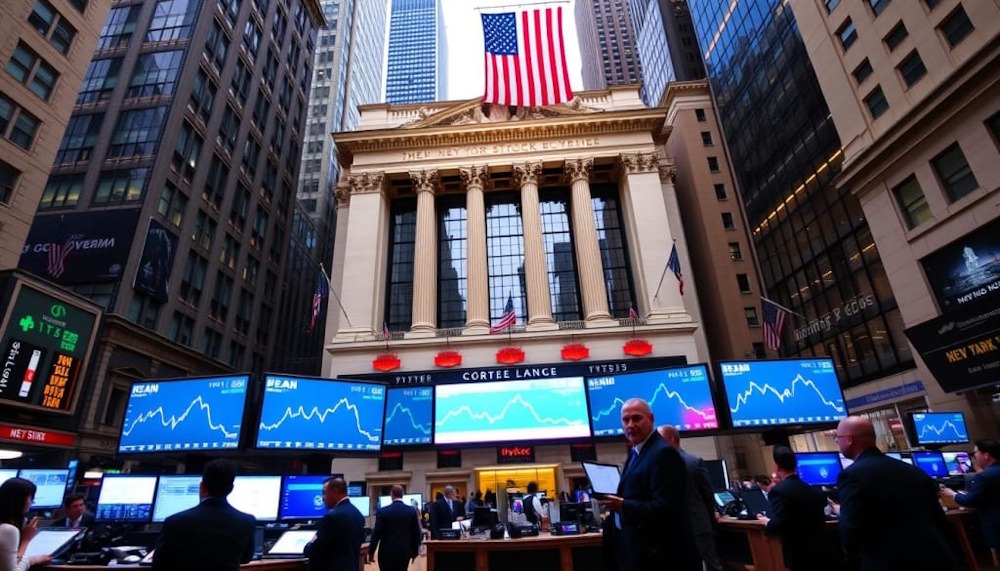
Dow futures show little movement, indicating a sense of caution among traders ahead of an important announcement regarding interest rates from the Federal Reserve. There is a prevailing consensus among market participants regarding the likelihood of the Fed reducing borrowing costs. However, the extent of these potential reductions and the central bank’s perspective on future rates continue to spark discussion. In other news, U.K. inflation remains stable as the Bank of England prepares for its rate decision later this week, while packaged foods company General Mills is set to lead the earnings announcements.
Futures for the Dow showed little movement on Wednesday, as market participants braced for the eagerly awaited decision on interest rates from the Federal Reserve. As of 03:30, the futures for the Dow, S&P 500, and Nasdaq 100 remained largely stable, with the Nasdaq 100 futures experiencing a slight increase of 19 points, or 0.1%. The primary indices on Wall Street declined in the previous session, as the U.S. dollar fell to new 52-week lows — indicative of a cautious sentiment ahead of the Federal Reserve’s forthcoming announcement. In individual stocks, Nvidia shares declined on a news report suggesting that demand for the semiconductor giant’s new AI chip in China has been weak. On the other hand, Oracle’s stock rose after the software group was rumored to be part of an investment consortium which, under a framework deal between the U.S. and China, will keep the U.S. arm of short-form video app TikTok in operation.
The Federal Reserve is anticipated to reduce interest rates at the end of its recent two-day policy meeting, yet the extent of the potential decrease and the accompanying remarks continue to be a topic of discussion. The consensus among analysts indicates a strong expectation that the central bank will reduce borrowing costs by a minimum of 25 basis points from the existing target range of 4.25% to 4.5%. Additionally, there remains a slight possibility of a more substantial cut of half a percentage point. The estimates are supported by indications of a weakening U.S. labor market, which appear to overshadow concurrent signs of persistent inflation. In principle, a reduction in rates may stimulate investment and employment, though it carries the potential risk of increasing inflation. The perspective of the rate-setting Federal Open Market Committee, particularly that of Chair Jerome Powell, regarding the direction of the job market and inflation will be closely scrutinized. Policymakers currently encounter challenges on both fronts of their dual mandate: enhancing employment and ensuring price stability. In addition to the qualitative remarks from the FOMC and Powell, the Fed will unveil an updated overview of its members’ rate projections for the upcoming months — a chart that garners significant attention, referred to as the “dot plot.” Inflation continues to exceed the target, and tariffs are expected to sustain elevated levels in the short term. However, analysts noted that the balance of risks leans towards the necessity for increased support for the economy.
In August, inflation in the U.K. remained stable, yet it was nearly double the target set by the Bank of England. This indicates that the central bank is likely to maintain its current monetary policy during the upcoming policy meeting on Thursday. In August, annual consumer price inflation increased by 3.8%, remaining steady from the July figure, yet it continues to be significantly higher than the Bank of England’s medium-term target of 2.0%. The figure for July 2025 marked the highest level since January 2024, at which point the rate stood at 4.0%. The monthly rate increased by 0.3%, outpacing the 0.1% growth recorded in the previous month. Core CPI, excluding the fluctuations of energy and food prices, increased by 0.3% month-over-month and 3.6% year-over-year, reflecting a modest decline from the 3.8% growth recorded in July.
General Mills is set to announce its earnings prior to the market opening. Investors will be monitoring the quarterly sales of the packaged foods firm and the outlook for future demand. Questions have arisen regarding the extent to which consumers are curbing their spending amidst a backdrop of economic uncertainty driven by tariffs. A measure of consumer sentiment from the University of Michigan declined last week, with broad U.S. tariffs identified as a significant factor contributing to households’ concerns about their financial well-being. General Mills is expected to announce fiscal first-quarter adjusted earnings per share of $0.82, with net sales projected at $4.52 billion, as per Bloomberg consensus estimates. The owner of brands such as Chex breakfast cereal and Nature Valley granola bars has experienced a decline of 22% in its shares this year.
Gold prices have slightly decreased from their record highs in anticipation of the forthcoming announcement regarding the Fed’s rate decision and policy outlook. Spot gold recently declined by 0.6% to $3,667.61 an ounce as of 03:30 ET, following an all-time high of $3,702.95 reached on Tuesday. Gold futures in the U.S. for December declined by 0.6%, settling at $3,704.20 per ounce. In the interim, oil prices experienced a slight decline, relinquishing a portion of the gains from the prior session amid increasing worries regarding potential disruptions in Russian production. The benchmarks closed over 1% higher on Tuesday, reaching two-week highs, influenced in part by concerns that Russian supplies could be affected after Ukrainian drone strikes targeted key export ports and refineries.
